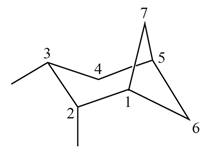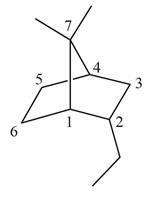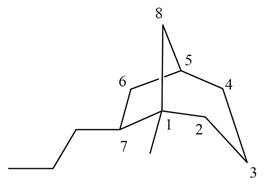
Concept explainers
Read Appendix B on naming bicyclic compounds. Then give IUPAC name for each of the following compounds.
a. 
b. 
c. 
d. 
(a)
Interpretation: The IUPAC name for the given bicyclic compound is to be stated.
Concept introduction: The root name of bicyclic compounds depends upon the number of carbon atoms present in the rings. The naming of bicyclic compounds is done as,
(1) The total number of carbon atoms in the molecule is to be counted. It represents the root name.
(2) The number of carbon atoms between the bridgeheads is to be counted and placed in square brackets in descending order.
(3) The word bicyclo is placed at the beginning of the name.
The general name such compounds is represented as
Answer to Problem 4.75P
The IUPAC name for the given bicyclic compound is
Explanation of Solution
The given bicyclic compound is shown below.

Figure 1
The given compound contains seven carbon atoms in the ring which are single bonded to each other. Therefore, the root name is heptane. In this case, there are
The IUPAC name for the given bicyclic compound is
(b)
Interpretation: The IUPAC name for the given bicyclic compound is to be stated.
Concept introduction: The root name of bicyclic compounds depends upon the number of carbon atoms present in the rings. The naming of bicyclic compounds is done as,
(1) The total number of carbon atoms in the molecule is to be counted. It represents the root name.
(2) The number of carbon atoms between the bridgeheads is to be counted and placed in square brackets in descending order.
(3) The word bicyclo is placed at the beginning of the name.
The general name such compounds is represented as
Answer to Problem 4.75P
The IUPAC name for the given bicyclic compound is
Explanation of Solution
The given bicyclic compound is shown below.

Figure 2
The given compound contains seven carbon atoms in the ring which are single bonded to each other. Therefore, the root name is heptane. In this case, there are
The IUPAC name for the given bicyclic compound is
(c)
Interpretation: The IUPAC name for the given bicyclic compound is to be stated.
Concept introduction: The root name of bicyclic compounds depends upon the number of carbon atoms present in the rings. The naming of bicyclic compounds is done as,
(1) The total number of carbon atoms in the molecule is to be counted. It represents the root name.
(2) The number of carbon atoms between the bridgeheads is to be counted and placed in square brackets in descending order.
(3) The word bicyclo is placed at the beginning of the name.
The general name such compounds is represented as
Answer to Problem 4.75P
The IUPAC name for the given bicyclic compound is
Explanation of Solution
The given bicyclic compound is shown below.

Figure 3
The given compound contains eight carbon atoms in the ring which are single bonded to each other. Therefore, the root name is octane. In this case, there are
The IUPAC name for the given bicyclic compound is
(d)
Interpretation: The IUPAC name for the given bicyclic compound is to be stated.
Concept introduction: The root name of bicyclic compounds depends upon the number of carbon atoms present in the rings. The naming of bicyclic compounds is done as,
(1) The total number of carbon atoms in the molecule is to be counted. It represents the root name.
(2) The number of carbon atoms between the bridgeheads is to be counted and placed in square brackets in descending order.
(3) The word bicyclo is placed at the beginning of the name.
The general name such compounds is represented as
Answer to Problem 4.75P
The IUPAC name for the given bicyclic compound is
Explanation of Solution
The given bicyclic compound is shown below.

Figure 4
The given compound contains seven carbon atoms in the ring which are single bonded to each other. Therefore, the root name is heptane. In this case, there are
The IUPAC name for the given bicyclic compound is
Want to see more full solutions like this?
Chapter 4 Solutions
Organic Chemistry
Additional Science Textbook Solutions
General Chemistry: Principles and Modern Applications (11th Edition)
Fundamentals of Heat and Mass Transfer
General, Organic, and Biological Chemistry - 4th edition
Chemistry: An Introduction to General, Organic, and Biological Chemistry (13th Edition)
- Write structural formulas for the following: a.o-ethylphenol b.m-chlorobenzoicacid c.3-methyl-3-phenylpentanearrow_forwardGive an IUPAC name for the following as hydrocarbons with the benzene ring as a substituent: a. b.arrow_forwardLimonene, which is present in citrus peelings, has a very pleasant lemonlike fragrance. However, it is not classified as an aromatic compound. Explain. limonenearrow_forward
 Chemistry for Today: General, Organic, and Bioche...ChemistryISBN:9781305960060Author:Spencer L. Seager, Michael R. Slabaugh, Maren S. HansenPublisher:Cengage Learning
Chemistry for Today: General, Organic, and Bioche...ChemistryISBN:9781305960060Author:Spencer L. Seager, Michael R. Slabaugh, Maren S. HansenPublisher:Cengage Learning Introductory Chemistry: An Active Learning Approa...ChemistryISBN:9781305079250Author:Mark S. Cracolice, Ed PetersPublisher:Cengage Learning
Introductory Chemistry: An Active Learning Approa...ChemistryISBN:9781305079250Author:Mark S. Cracolice, Ed PetersPublisher:Cengage Learning

